19 abril, 2024
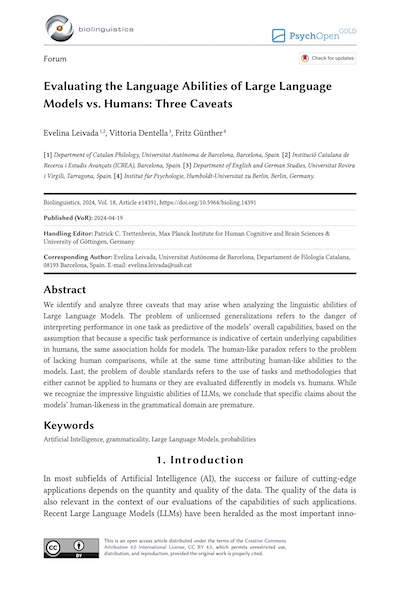
Autors:
Evelina Leivada, Vittoria Dentella & Fritz Günther
Títol:
Biolinguistics, vol.18Editorial: PsychOpen
Data de publicació: 19 abril, 2024
Text completWe identify and analyze three caveats that may arise when analyzing the linguistic abilities of Large Language Models. The problem of unlicensed generalizations refers to the danger of interpreting performance in one task as predictive of the models’ overall capabilities, based on the assumption that because a specific task performance is indicative of certain underlying capabilities in humans, the same association holds for models. The human-like paradox refers to the problem of lacking human comparisons, while at the same time attributing human-like abilities to the models. Last, the problem of double standards refers to the use of tasks and methodologies that either cannot be applied to humans or they are evaluated differently in models vs. humans. While we recognize the impressive linguistic abilities of LLMs, we conclude that specific claims about the models’ human-likeness in the grammatical domain are premature.
27 febrer, 2023
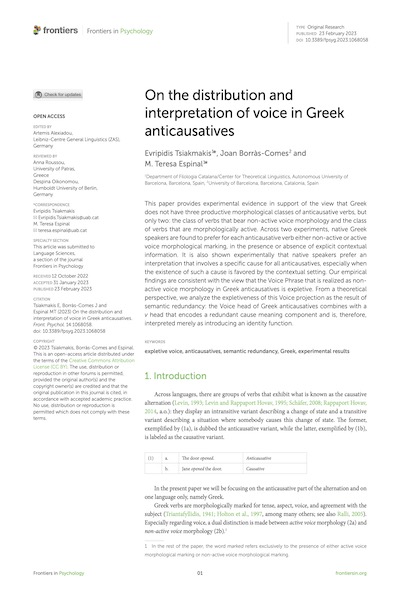
Autors:
Evripidis Tsiakmakis, Joan Borràs-Comes i M.Teresa Espinal
Títol:
On the distribution and interpretation of voice in Greek anticausatives. Frontiers in PsychologyEditorial: Frontiers
Data de publicació: 23 de febrer del 2023
Pàgines: 15 Text completThis paper provides experimental evidence in support of the view that Greek does not have three productive morphological classes of anticausative verbs, but only two: the class of verbs that bear non-active voice morphology and the class of verbs that are morphologically active. Across two experiments, native Greek speakers are found to prefer for each anticausative verb either non-active or active voice morphological marking, in the presence or absence of explicit contextual information. It is also shown experimentally that native speakers prefer an interpretation that involves a specific cause for all anticausatives, especially when the existence of such a cause is favored by the contextual setting. Our empirical findings are consistent with the view that the Voice Phrase that is realized as non-active voice morphology in Greek anticausatives is expletive. From a theoretical perspective, we analyze the expletiveness of this Voice projection as the result of semantic redundancy: the Voice head of Greek anticausatives combines with a v head that encodes a redundant cause meaning component and is, therefore, interpreted merely as introducing an identity function.
13 abril, 2023
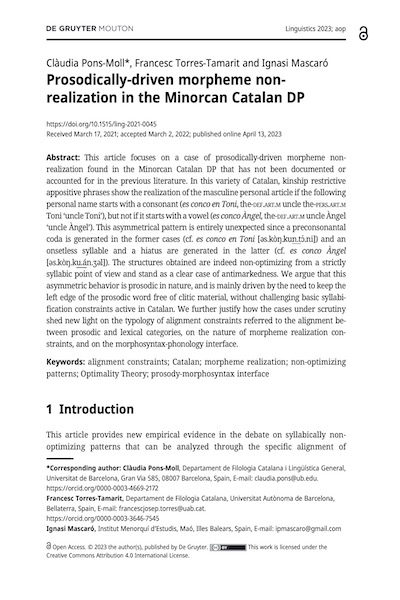
Autors:
Clàudia Pons-Moll, Francesc Torres-Tamarit i Ignasi Mascaró
Títol:
Prosodically-driven morpheme non-realization in the Minorcan Catalan DPEditorial: Linguistics, De Gruyter Mouton
Data de publicació: Abril del 2023
Més informació
Text completThis article focuses on a case of prosodically-driven morpheme non-realization found in the Minorcan Catalan DP that has not been documented or accounted for in the previous literature. In this variety of Catalan, kinship restrictive appositive phrases show the realization of the masculine personal article if the following personal name starts with a consonant (es conco en Toni, the-def.art.m uncle the-pers.art.m Toni ‘uncle Toni’), but not if it starts with a vowel (es conco Àngel, the-def.art.m uncle Àngel ‘uncle Àngel’). This asymmetrical pattern is entirely unexpected since a preconsonantal coda is generated in the former cases (cf. es conco en Toni [əs.kòŋ.kun.tɔ́.ni]) and an onsetless syllable and a hiatus are generated in the latter (cf. es conco Àngel [əs.kòŋ.ku.án.ʒəl]). The structures obtained are indeed non-optimizing from a strictly syllabic point of view and stand as a clear case of antimarkedness. We argue that this asymmetric behavior is prosodic in nature, and is mainly driven by the need to keep the left edge of the prosodic word free of clitic material, without challenging basic syllabification constraints active in Catalan. We further justify how the cases under scrutiny shed new light on the typology of alignment constraints referred to the alignment between prosodic and lexical categories, on the nature of morpheme realization constraints, and on the morphosyntax-phonology interface.
19 juny, 2023
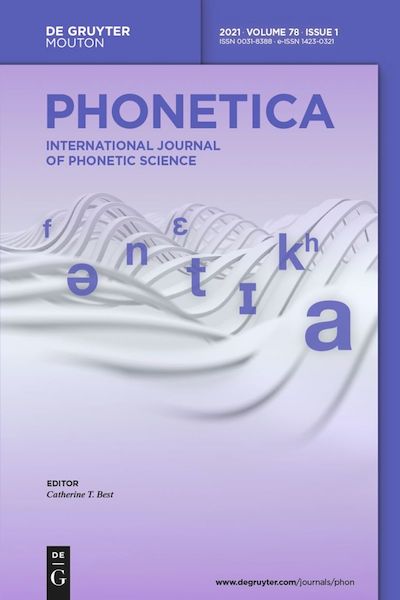
Autors:
Silke Hamann & Francesc Torres-Tamarit
Títol:
Merger in Eivissan Catalan: an acoustic analysis of the vowel systems of young native speakersEditorial: Phonetica (De Gruyter)
Data de publicació: 16 juny 2023
Més informacióThe vowel system of Catalan has been the focus of many studies, though work on the varieties spoken on the island of Eivissa (Ibiza) are scarce, with a single mention of the possible merger of the mid back vowels /o, ɔ/ (Torres Torres, Marià. 1983. Aspectes del vocalisme tònic eivissenc. Eivissa 14. 22–23). The present article provides the first acoustic analysis of the vowel inventory of 25 young native speakers of Eivissan Catalan, with a focus on the realisations of stressed /ə, ɛ/, and the back mid vowels /o, ɔ/. We employed Pillai scores (Hay, Jennifer, Paul Warren & Katie Drager. 2006. Factors influencing speech perception in the context of a merger-in-progress. Journal of Phonetics 34. 458–484) to compare the possibly merged pairs /ə, ɛ/ and /o, ɔ/ to the fully-contrasting neighbouring pairs /e, ɛ/ and /o, u/. Our results show that all participants had considerable overlap of stressed /ə/ and /ɛ/, and all but one had considerable overlap of the back mid vowels, while the fully contrastive pairs (/e, ɛ/ and /o, u/) showed almost no overlap.
4 setembre, 2023
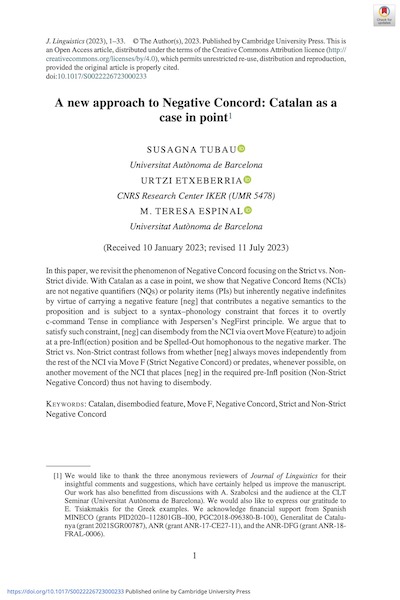
Autors:
Susagna Tubau, Urtzi Etxeberria i M.Teresa Espinal
Títol:
A new approach to Negative Concord: Catalan as a case in pointEditorial: Journal of Linguistics (Cambridge University Press)
Data de publicació: Juliol del 2023
Pàgines: 33 Més informacióIn this paper, we revisit the phenomenon of Negative Concord focusing on the Strict vs. Non-Strict divide. With Catalan as a case in point, we show that Negative Concord Items (NCIs) are not negative quantifiers (NQs) or polarity items (PIs) but inherently negative indefinites by virtue of carrying a negative feature [neg] that contributes a negative semantics to the proposition and is subject to a syntax–phonology constraint that forces it to overtly c-command Tense in compliance with Jespersen’s NegFirst principle. We argue that to satisfy such constraint, [neg] can disembody from the NCI via overt Move F(eature) to adjoin at a pre-Infl(ection) position and be Spelled-Out homophonous to the negative marker. The Strict vs. Non-Strict contrast follows from whether [neg] always moves independently from the rest of the NCI via Move F (Strict Negative Concord) or predates, whenever possible, on another movement of the NCI that places [neg] in the required pre-Infl position (Non-Strict Negative Concord) thus not having to disembody.









